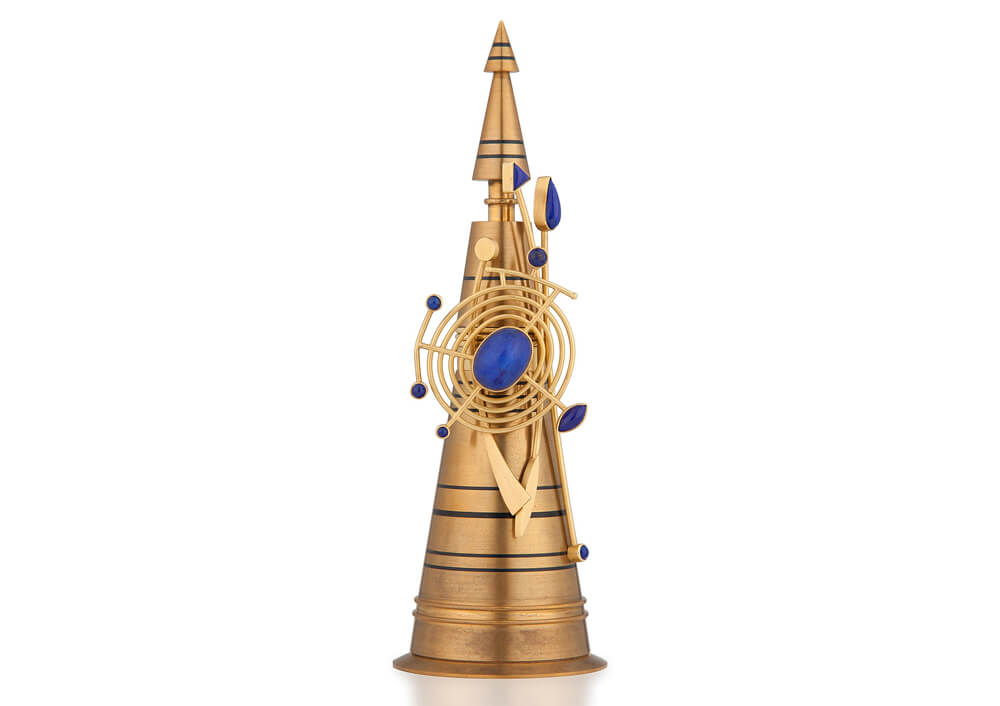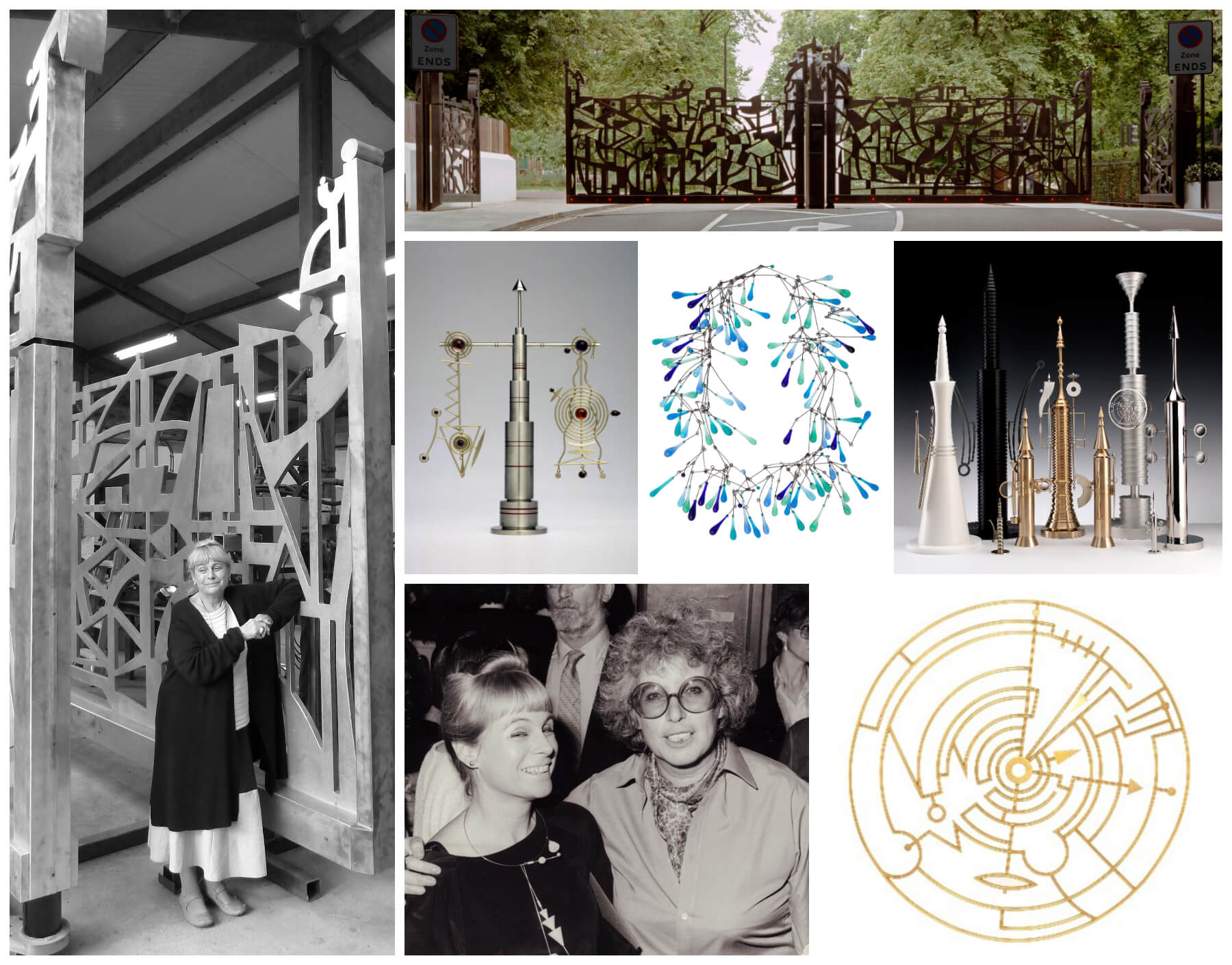Wendy Ramshaw FCSD FRSA OBE RDI CBE 1939 – 2018
Reading Time:
1 min {{readingTime}} mins
Wendy Ramshaw was an internationally acclaimed jeweller, designer and artist. Her worked spanned the 1960s through to present day and she can be charged with being at the forefront of the ‘new wave’ of jewellery which emerged in the mid twentieth century pioneering the use of alternative materials which formed the basis of ‘designer’ and ‘art’ jewellery movements, which we see today.
Born in Sunderland in on the 26 May 1939, Wendy Anne Jopling Ramshaw was the daughter of Angus and Flora (nee Hollingshead), a Tyne and Wear family, which was based in the shipping industry.
As a girl she attended Sunderland girls’ high school and St Mary’s Convent in Berwick-upon-Tweed and went on to study illustration and fabric design at the College of Art and Industrial Design, Newcastle upon Tyne, 1956-60. She then attended Reading University to study for a teaching diploma 1960-61, and then went on to further study at postgraduate level in jewellery the Central School of Art and Design in 1969-70.
It was in their period of her life, in 1961, at the University of Reading, were she met her life-long partner, the sculptor, designer, and jeweller, David Watkins whom she married in 1962 and embarked on and continued in partnership with many collaborative projects and exhibitions.
Ramshaw first drew attention when her paper jewellery, which had to be cut out and assembled from paper patterns by the wearer, was selected by Mary Quant for her London boutique in the 1960s and model Twiggy was photographed wearing them.

Around 1965 Ramshaw developed what would be known as her signature pieces, which consisted of a number of gold rings stored on a single post, their own storage facility. These ‘ring sets’ or 'pillar rings' were seen as a novel way to store jewellery with a central stand modelled in space age abstract and modernistic styles with the jewellery displayed on them often embellished with a coloured array of gemstones. Although two separate objects in their own right, when placed together, the two formed a miniature sculptural quality. This concept won her the Design Council Award for Innovation in 1972 and the ring sets are now housed in 70 public collections worldwide, including the Goldsmiths' Company, the Victoria & Albert Museum, National Museums Scotland, Art Gallery of Western Australia, the British Museum, Metropolitan Museum of Art and the National Museum of Modern Art in Kyoto.
A solo exhibition followed at the Pace Gallery in London in 1970, and then a further solo exhibition was hosted by the Electrum Gallery and in 1972 she was given a Design Council Award. Together with fellow jeweller David Watkins, Ramshaw displayed work at the Helen Drutt Gallery in Philadelphia, USA in 1973, followed by and exhibition at Goldsmiths’ Hall, London. From 1977 Ramshaw had shown more than 30 solo exhibitions internationally including a major retrospective at the Victoria and Albert Museum, London, in 1982.

From the 1980s onward Wendy worked on a new bodies of work, notably ‘Picasso’s Ladies’, a series of jewellery founded on images of portraits of women the artist had painted between 1904 and 1962. This collection went on to be displayed at the V&A in 1998, and then at the American Craft Museum, New York, in 1999, and then again as an installation piece at the Museum Künstlerkolonie in Darmstadt, Germany in 2001. Other exhibitions included Rooms of Dreams, 2002, which conceived for presentation at the Scottish Gallery, Edinburgh, and later shown in part at Somerset House, London, and then again exhibited at the Birmingham City Museum and Art Gallery, 2015-16; Prospero's Table,2004; and a Journey Through Glass, 2007.
Ramshaw also played with scale and wider product design and went on to win large architectural commissions. The most notable, the ‘New Edinburgh Gate’ at the Knightsbridge entrance to Hyde Park in central London reflects her preoccupation with the geometric form. Other commissions include a gate for the Fellows’ Garden at St John’s College, Oxford, 1993; a screen for the entrance to the staff restaurant at the V&A, 1996; a screen for Columbus Garden at Canary Wharf, London, 2000, and gates for the Kendrew Quadrangle at St John’s College, Oxford.
In 1973 she was made a Freeman of the Worshipful Company of Goldsmiths, made Liveryman in 1986 and in 1993 she was awarded Officer of the Order of the British Empire (OBE) by the Queen for services to the Arts. Wendy Ramshaw has been visiting Professor at the Royal College of Art in London between 1996 and 1999. In 1999 she became an honorary fellow of the London Institute, and was also elected Royal Designer for Industry (RDI). In 2000 she was appointed a Royal Designer for Industry, and in 2003 she was honoured as a Commander of the Order of the British Empire (CBE) for services to art.
Arguably one of the most important and significant jewellery designers Britain has produced, Wendy Ramshaw’s name is associated with international acclaim. As an ambassador for contemporary jewellery for some sixty years, her work as a jeweller, designer, artist and educator has engendered inspiration and forged a creative pathway for generations which have succeeded her.
Wendy passed away on Sunday 9th December after a long illness and is survived by her partner, Prof. David Watkins, her children, Miranda and Richard, and grandson, Jackson.
Further reading:
Benchpeg Q&A
benchpeg.com/qanda/wendy-ramshaw
Wendy Ramshaw Biography
www.ramshaw-watkins.com/wr/biography.htm
Author:
Published:








